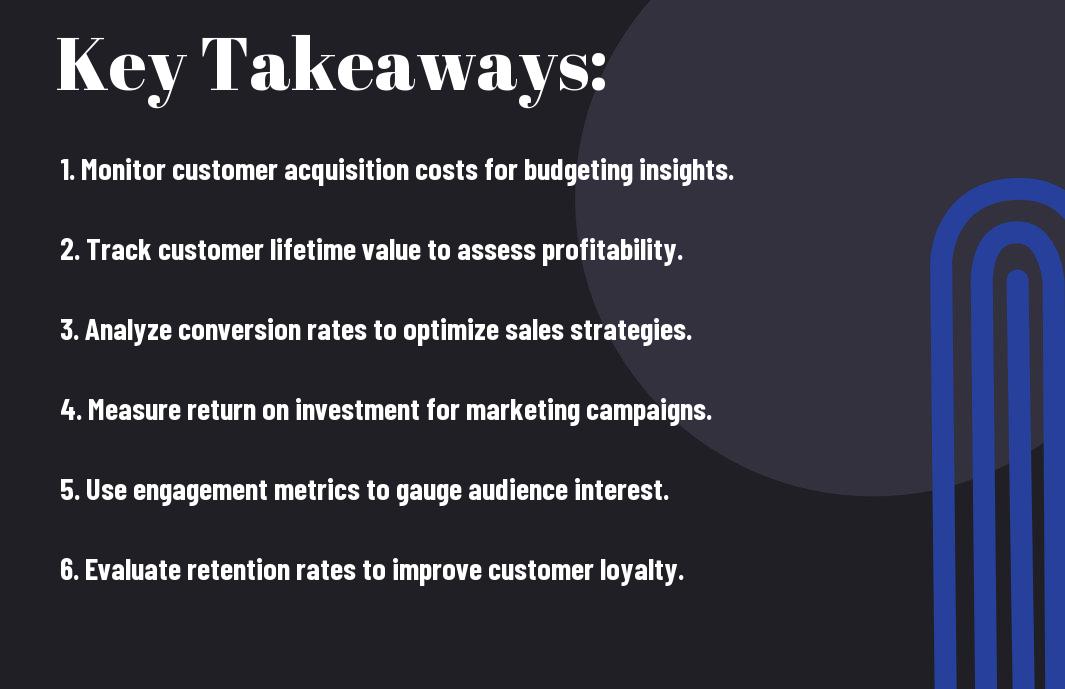Over time, successfully measuring your marketing efforts can significantly impact your revenue growth. Understanding key performance indicators can help you fine-tune your strategies and make informed decisions. By focusing on relevant metrics, you can gain insights into customer behavior, campaign effectiveness, and overall business health. In this post, you will discover the crucial metrics that can drive your marketing success and help you achieve sustainable growth for your business. Equip yourself with the knowledge to track your progress and maximize your marketing ROI.

Key Takeaways:
- Customer Acquisition Cost (CAC): Understanding the cost involved in acquiring a new customer is vital for evaluating marketing effectiveness and informing budget decisions.
- Return on Investment (ROI): Measuring the revenue generated from marketing efforts relative to the cost incurred allows businesses to assess the profitability of their campaigns.
- Conversion Rate: Tracking how many prospects turn into paying customers helps identify successful marketing strategies and areas needing improvement.

Defining Marketing Success
The definition of marketing success often varies from one business to another. It encompasses various outcomes, including increasing brand awareness, improving customer engagement, and ultimately driving revenue growth. To dive deeper into imperative marketing metrics, explore The 6 Growth Marketing Metrics Every Business Needs to …, which can guide your evaluation of success.
What Constitutes Marketing Success
For your marketing efforts to be deemed successful, you should focus on tangible results such as lead generation, conversion rates, and customer retention. Achieving these results often signifies that you are creating meaningful connections with your audience and delivering value through your offerings.
Aligning Metrics with Business Goals
Business success hinges on the alignment between your marketing metrics and your overall objectives. Ensuring that your marketing strategies directly contribute to your goals can lead to improved outcomes and better resource allocation.
In addition, aligning your metrics with business goals helps you identify what truly matters for your growth. By closely monitoring metrics such as customer lifetime value and return on investment, you can focus on initiatives that drive the most significant growth. This strategic alignment allows you to allocate resources effectively while adapting your tactics in response to market demands, paving the way for long-term success.
Key Performance Indicators (KPIs)
Any marketing strategy should be driven by clear metrics and KPIs that can assess the effectiveness of your efforts. Effective tracking of these indicators not only helps you gauge current performance but also guides your decisions to optimize campaigns for future success. By focusing on specific KPIs, you can evaluate how your marketing efforts translate into actionable insights and revenue growth.
Conversion Rate
About measuring the percentage of visitors who complete a desired action on your website, your conversion rate is an necessary metric. This might include actions such as making a purchase, signing up for a newsletter, or filling out a contact form. A high conversion rate indicates that your marketing strategies are effectively engaging your audience.
Customer Acquisition Cost
For every business, understanding your customer acquisition cost (CAC) is key to profitability. This metric calculates the total cost associated with acquiring a new customer, including marketing expenses, sales staff salaries, and overhead costs. Evaluating your CAC not only informs your budgeting decisions but also highlights areas for optimizing your marketing spend.
At its core, Customer Acquisition Cost provides insight into the efficiency of your marketing strategies. If your CAC is too high compared to the lifetime value (LTV) of a customer, it can serve as a red flag for your business model and profitability. By actively monitoring this metric, you can identify inefficiencies in your marketing tactics, allowing you to adjust your approach and optimize investment. Ensuring your CAC remains manageable is a key step toward achieving sustainable growth and maximizing your return on investment.

Revenue Metrics
Many businesses rely on revenue metrics to gauge their financial health and assess the effectiveness of their marketing strategies. These metrics not only provide insight into current profitability but also help forecast future performance. By focusing on key revenue indicators, you can make informed decisions that lead to sustained growth and improved ROI.
Monthly Recurring Revenue
Between the various revenue metrics, Monthly Recurring Revenue (MRR) stands out as a vital measure for subscription-based businesses. It represents the predictable and recurring income your business expects each month, allowing you to track growth trends and assess the long-term viability of your offerings.
Customer Lifetime Value
Monthly Customer Lifetime Value (CLV) indicates how much revenue you can expect from a single customer throughout their relationship with your business. This metric allows you to evaluate the effectiveness of your customer acquisition strategies and ultimately aids in budget allocation for marketing efforts.
Plus, understanding your Customer Lifetime Value helps you identify your most valuable customers. By focusing on maintaining strong relationships with those customers, you can maximize their spending potential. If your CLV is higher than your customer acquisition cost, you're on the right path to profitability. However, if it's lower, you need to reassess your marketing strategies to cultivate customer loyalty and encourage repeat business. This metric is necessary for aligning your operations with revenue growth objectives.
Engagement Metrics
Despite having strong marketing strategies, your efforts can fall flat without effectively measuring engagement metrics. These metrics provide valuable insights into how your audience interacts with your content, allowing you to refine strategies and improve overall marketing performance. Tracking engagement helps you understand your customers better, ensuring you deliver the right message at the right time to boost conversions and revenue growth.
Website Traffic
For your marketing to succeed, it's necessary to monitor website traffic. Analyzing the number of visitors to your site can help gauge the effectiveness of your campaigns. Increased traffic suggests that your marketing efforts are driving interest in your brand, while stagnant or declining numbers may indicate a need for strategic adjustments.
Social Media Engagement
Among the various engagement metrics, social media engagement stands out as a key indicator of how well your audience connects with your brand. Whether it's likes, shares, comments, or follows, these interactions reflect your audience's interest and affinity toward your content.
This engagement not only boosts your brand's visibility but also fosters community building and increases the likelihood of customer loyalty. By actively responding to and interacting with your audience, you can cultivate a deeper connection and encourage word-of-mouth marketing. However, it's vital to monitor negative feedback or interactions as they can impact your brand's reputation. Thus, prioritizing authentic communication and engagement on your social media platforms can drive meaningful relationship-building and ultimately enhance your revenue potential.
Analyzing and Interpreting Data
Keep in mind that analyzing and interpreting data is crucial for understanding your marketing success and revenue growth. By keeping a close eye on your analytics, you can make informed decisions that propel your business forward. To learn more about the specific metrics that can enhance your insights, check out 11 Key Business Growth Metrics to Measure.
Tools for Data Analysis
Behind every successful marketing strategy lies the right tools for data analysis. Utilizing advanced analytics software helps you decipher complex datasets, uncover trends, and visualize performance effectively. Popular tools such as Google Analytics, Tableau, and HubSpot provide you with the resources necessary to gather insights and streamline your analysis, ultimately enhancing your decision-making processes.
Making Data-Driven Decisions
Data-driven decisions are crucial for aligning your marketing strategies with tangible results. By closely examining your analytics, you can identify patterns that inform your next steps. Making decisions based solely on gut feelings can lead to missed opportunities and wasteful expenditure of resources. Use your data to pinpoint successful campaigns and optimize your marketing efforts for future growth.
It's important to actively engage with your data to unlock valuable insights that can guide your strategies. Run experiments based on your findings to see what works best, allowing your business to adapt swiftly. Failing to embrace data-driven decision-making can result in stagnation and frustration. Utilize your analytics not just for tracking performance but as a proactive measure that ensures you stay ahead in your marketing efforts and continuously drive revenue growth.
Continuous Improvement Strategies
Now that you have established key metrics, it's important to embrace continuous improvement strategies to enhance your marketing efforts. This process involves regularly evaluating your strategies and outcomes, allowing you to adapt and grow in response to changing market dynamics or consumer preferences. By fostering a culture of innovation and flexibility, you effectively position your brand for sustained success and revenue growth.
A/B Testing
Continuous experimentation is at the heart of A/B testing, where you compare two versions of a marketing element to identify which one performs better. This method allows you to make data-backed decisions that enhance your campaigns, ensuring you connect more effectively with your audience while optimizing resources.
Adjusting Marketing Strategies Based on Insights
For optimal results, it's vital to adjust your marketing strategies based on the insights gathered from your performance metrics. This means continuously analyzing data and feedback from your campaigns to identify trends or patterns that can inform your approach.
Adjusting your marketing strategies according to insights ensures that you stay relevant and effective in your efforts. By actively seeking feedback and performance data, you can pivot your campaigns toward what resonates most with your audience. This not only highlights areas for improvement but also directs resources toward the most promising tactics, ultimately driving higher engagement and a better return on investment for your marketing initiatives.

Final Words
So, as you navigate the landscape of marketing success and revenue growth, ensure you keep a close eye on vital metrics like customer acquisition cost, return on investment, and conversion rates. These metrics not only provide insights into the effectiveness of your strategies but also inform your decision-making processes. By regularly analyzing these figures, you empower yourself to make data-driven adjustments that optimize your marketing efforts and drive sustainable growth. Your ability to track and interpret these metrics will ultimately shape the success of your marketing endeavors.
FAQ
Q: What are the most important metrics to measure marketing success?
A: When evaluating marketing success, several key metrics can provide insight into performance. These include Customer Acquisition Cost (CAC), which measures the total cost of acquiring a new customer, and Return on Investment (ROI), which assesses the profitability of specific marketing campaigns. Additionally, tracking metrics such as Customer Lifetime Value (CLV) helps in understanding the long-term value a customer brings, while conversion rates reveal how effective your marketing efforts are at turning leads into sales. Monitoring these metrics can help marketers make informed decisions and optimize their strategies for better outcomes.
Q: How can I effectively track revenue growth related to marketing efforts?
A: To effectively track revenue growth associated with marketing efforts, businesses should utilize a combination of analytics tools and key performance indicators (KPIs). Implementing a Customer Relationship Management (CRM) system will allow you to monitor individual customer interactions and their resulting purchases. Additionally, using tools like Google Analytics can track website traffic and the conversion paths that lead to sales. Keeping an eye on metrics such as sales growth attributed to marketing campaigns, market share changes, and customer retention rates can provide a comprehensive view of how marketing strategies impact overall revenue growth.
Q: How often should I analyze marketing metrics for optimal results?
A: The frequency of analyzing marketing metrics can vary based on business needs and goals. However, a good practice is to review key metrics on a monthly basis to assess ongoing performance and identify trends. For campaigns that are shorter in duration, such as promotions or product launches, a weekly analysis would be beneficial. Additionally, conducting a deeper analysis quarterly can help in adjusting long-term strategies based on accumulated data and overall performance. This approach ensures that you stay agile and responsive to changes in the market and customer behavior.


